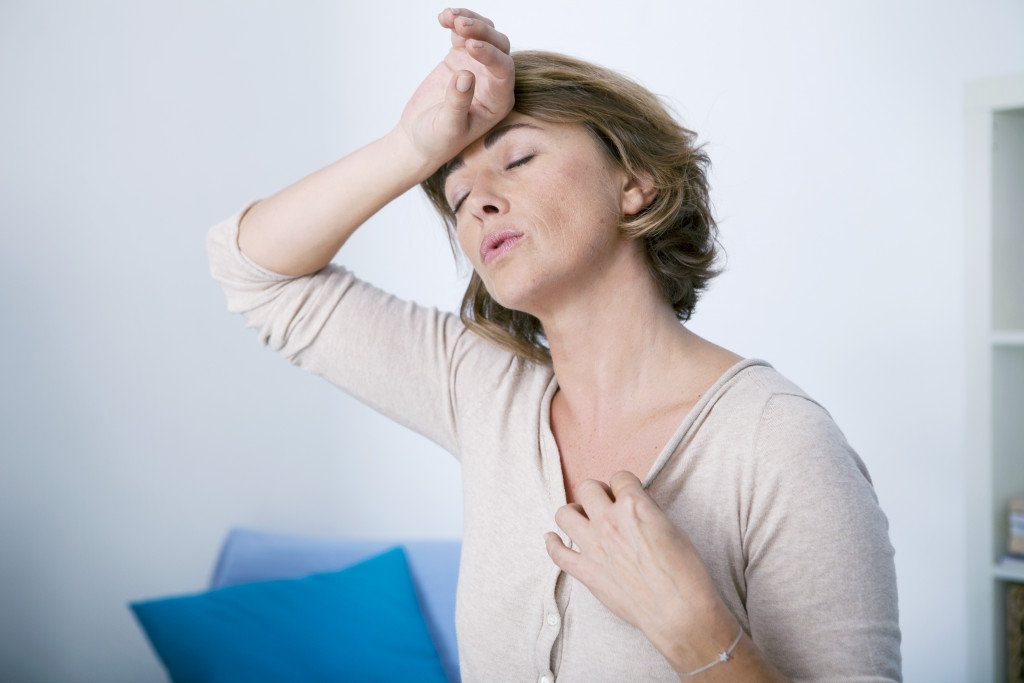Are you the type of woman who constantly feels like she’s about to break a sweat? Either way, too much sweating is not good for your body or health, especially when you’re already in pre-menopause and menopausal stages.
With this in mind, we take a closer look at what’s going on beneath the surface regarding women and menopause and all that perspiration.
Why Older Women Sweat a Lot
First, what is menopause? It refers to a phase where women stop having periods. Unlike men, as soon as they are born, women already have all the eggs cells they would need to conceive a child.
As they grow older, the quantity and quality of these eggs decline. By the time they are nearing menopause, around 35 to 45 years old, they might already have about 10,000 eggs left. But not all will be ripe for ovulation. When a woman goes through this last phase of fertility, the ovaries, which store these eggs, won’t release these cells anymore.
But the lack of menstruation isn’t the only noticeable change among women with menopause. They are also likely to experience other symptoms: excessive sweating, especially in the evening.
The connection between menopause and sweating might not seem obvious. Still, many women find their temperatures are higher during menopause than in pre-menopause—sometimes significantly so.
The average temperature of a healthy human being is 98.6 degrees Fahrenheit (37 degrees Celsius). A hot flash could raise that by about five to seven degrees more.
What’s going on when there is no sign that you have the flu and yet you feel hot all over? For women in menopause, it might be a case of “too much estrogen.” Before we expand on this thought, let’s backtrack for a moment to take a look at how our bodies handle estrogen levels.
The HPO Axis
Estrogen has a huge effect on our women’s bodies. As one of the female hormones, it is responsible for the development of sex organs. It regulates fat distribution and water retention, helps prevent osteoporosis (loss of bone mineral density) and heart disease, and improves mood. It also has a direct impact on thermal regulation by being part of the HPO axis.
HPO stands for hypothalamus, pituitary gland, and ovaries (HPO axis). The HPO axis is responsible for keeping our reproductive organs primed for reproduction by releasing hormones. All these body parts work in a feedback loop system.
The hypothalamus and pituitary glands are all parts of the brain, where the former acts as the body’s thermostat. It means it can help control body temperature. As part of the HPO axis, it regulates hormone levels present in the bloodstream.

When it senses that estrogen levels are low, the hypothalamus secretes a hormone known as gonadotropin-releasing hormone. This stimulates the pituitary gland to produce the follicle-stimulating hormone and luteinizing hormone, which signals the ovaries to produce hormones necessary for reproduction.
Once women reach menopause, this cascade of chemical communication begins to break down. As a result, the hypothalamus produces less GnRH, so less FSH and LH are released from the pituitary gland. Without these two levies, estrogen declines—as does progesterone. As such, when estrogen levels decline as women enter into menopause, they could experience hot flashes.
What are hot flashes? Hot flashes are a sudden feeling of abnormal warmth all over the body. They can happen suddenly and without warning. They can also last between 30 seconds and ten minutes as blood vessels narrow in the skin (vasoconstriction), which cools the body’s surface temperature. As you might imagine, this vasoconstrictive reaction can also result in sweating.
In addition to the hypothalamus’s role in regulating temperature, it also affects mood and sleep. If your hypothalamus isn’t able to do its job properly due to a decline in estrogen levels during menopause, you might find yourself feeling tired all the time as well as having trouble sleeping—a recipe for hot flashes!
How to Deal with Sweating and Hot Flashes during Menopause
Unfortunately, there is no cure for the menopausal hot flash (also called a hot flush or night sweat). However, many women can learn to reduce night sweats during menopause and deal with other related symptoms such as poor sleep quality.
- Change sheets and nightdresses often and use comfortable and airy beds.
- Keep your sleeping area cool with air-conditioning or a fan (or open the window if it’s not too cold). Some women find that using a personal deodorant spray on their body and bedding helps to keep them feeling fresh.
- If you sleep in a nightgown, don’t wear anything too loose or baggy. For example, if your gown is cotton, make sure it has a snug fit around the neck so that heat doesn’t escape at this area.
- Wear nylon stockings instead of pantyhose to help prevent overheating while sleeping.
- Cut down on fluid intake in the evening so that you are not up at night getting a drink.
- Drink lots of fluids daily and eat foods high in water content such as fruit and vegetables to stay hydrated. Some women use herbal teas such as “cooling” peppermint or chamomile, but be careful not to drink too much as some herbal teas can irritate the bladder.
- Take off a layer of clothing or apply less moisturizer (if you use menopausal cream) when you start feeling hot.
- If your night sweats are severe and uncontrolled, then speak with your doctor about taking hormone replacement therapy (HRT). However, it is important to remember that HRT may not alleviate all uncomfortable symptoms and may have more side effects than other treatments. If you decide on trying HRT, be sure to discuss the risks versus benefits with your doctor before starting this treatment.
While you’re dealing with all sorts of menopausal symptoms, excessive sweating can be uncomfortable, annoying, and anxiety-inducing. It doesn’t help that it doesn’t have any cure. However, you are born in an age where options to manage it well are already available. All you have to do is to maximize them.



